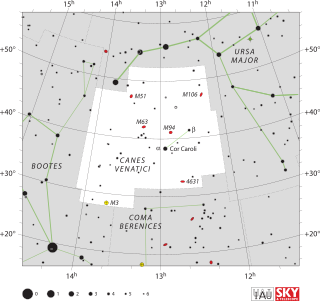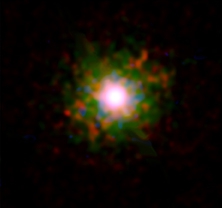
Capricornus is one of the constellations of the zodiac. Its name is Latin for "horned goat" or "goat horn" or "having horns like a goat's", and it is commonly represented in the form of a sea-goat: a mythical creature that is half goat, half fish. Its symbol is .

Centaurus is a bright constellation in the southern sky. One of the largest constellations, Centaurus was included among the 48 constellations listed by the 2nd-century astronomer Ptolemy, and it remains one of the 88 modern constellations. In Greek mythology, Centaurus represents a centaur; a creature that is half human, half horse. Notable stars include Alpha Centauri, the nearest star system to the Solar System, its neighbour in the sky Beta Centauri, and V766 Centauri, one of the largest stars yet discovered. The constellation also contains Omega Centauri, the brightest globular cluster as visible from Earth and one of the largest known.

Canes Venatici is one of the 88 official modern constellations. It is a small northern constellation that was created by Johannes Hevelius in the 17th century. Its name is Latin for "hunting dogs", and the constellation is often depicted in illustrations as representing the dogs of Boötes the Herdsman, a neighboring constellation. Cor Caroli is the constellation's brightest star, with an apparent magnitude of 2.9. La Superba is one of the reddest stars in the sky and one of the brightest carbon stars. The Whirlpool Galaxy is a spiral galaxy tilted face-on to observers on Earth, and was the first galaxy whose spiral nature was discerned.

Fornax is a constellation in the southern sky, partly ringed by the celestial river Eridanus. Its name is Latin for furnace. It was named by French astronomer Nicolas Louis de Lacaille in 1756. Fornax is one of the 88 modern constellations.

Lupus is a constellation located in the deep Southern Sky. Its name is Latin for wolf. Lupus was one of the 48 constellations listed by the 2nd century astronomer Ptolemy, and it remains one of the 88 modern constellations, although it was previously an asterism associated with the neighboring constellation Centaurus.

Octans is a faint constellation located in the deep southern sky. Its name is Latin for the eighth part of a circle, but it is named after the octant, a navigational instrument. The constellation was devised by French astronomer Nicolas Louis de Lacaille in 1752, and it remains one of the 88 modern constellations.

Pyxis is a small and faint constellation in the southern sky. Abbreviated from Pyxis Nautica, its name is Latin for a mariner's compass. Pyxis was introduced by Nicolas-Louis de Lacaille in the 18th century, and is counted among the 88 modern constellations.

Virgo is one of the constellations of the zodiac. Its name is Latin for virgin, and its symbol is ♍. Lying between Leo to the west and Libra to the east, it is the second-largest constellation in the sky and the largest constellation in the zodiac. It can be easily found through its brightest star, Spica.

Sculptor is a small and faint constellation in the southern sky. It represents a sculptor. It was introduced by Nicolas Louis de Lacaille in the 18th century. He originally named it Apparatus Sculptoris, but the name was later shortened.

Horologium is a faint constellation in the southern sky. It was devised by French astronomer Nicolas Louis de Lacaille in 1752, and it remains one of the 88 modern constellations. The constellation's brightest star is Alpha Horologii, an orange giant. R Horologii is a red giant Mira variable with one of the widest ranges in brightness known. Three star systems have exoplanets, while Nu Horologii has a debris disk.

Draco is a constellation in the far northern sky. Its name is Latin for dragon. It was one of the 48 constellations listed by the 2nd century astronomer Ptolemy, and remains one of the 88 modern constellations today. The north pole of the ecliptic is in Draco. Draco is circumpolar, and can be seen all year from northern latitudes.

NGC 5315 is a planetary nebula in the constellation Circinus. Of apparent magnitude 9.8 around a central star of magnitude 14.2, it is located 5.2 degrees west-southwest of Alpha Circini. It is only visible as a disc at magnifications over 200-fold. It was discovered by astronomer Ralph Copeland in 1883.

Not to be confused with Cygnus X-1

Arp 273 is a pair of interacting galaxies, lying 300 million light years away in the constellation Andromeda. It was first described in the Atlas of Peculiar Galaxies, compiled by Halton Arp in 1966. The larger of the spiral galaxies, known as UGC 1810, is about five times more massive than the smaller galaxy. It has a disc that is tidally distorted into a rose-like shape by the gravitational pull of the companion galaxy below it, known as UGC 1813. The smaller galaxy shows distinct signs of active star formation at its nucleus, and "it is thought that the smaller galaxy has actually passed through the larger one."

NGC 5823 (Caldwell 88) is an open cluster in the southern constellation of Circinus, near its border with the constellation Lupus. It was discovered by Scottish astronomer James Dunlop in 1826.

NGC 50 is an elliptical galaxy in the constellation Cetus with a diameter of 170,000 light-year's. It was discovered in 1865 by Gaspare Ferrari. The galaxy is, in comparison to the Milky Way, about 1.5-2 times as large. It is also physically close to NGC 49.
According to traditional Chinese uranography, the modern constellation Circinus is located within the eastern quadrant of the sky, which is symbolized as the Azure Dragon of the East.
















